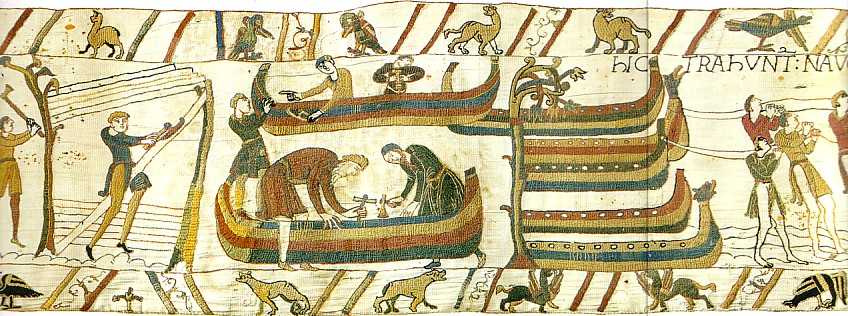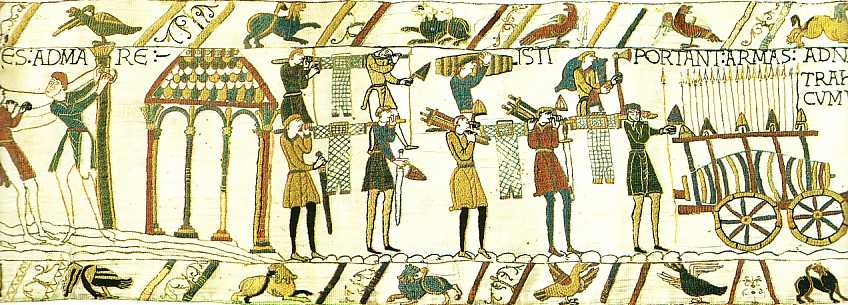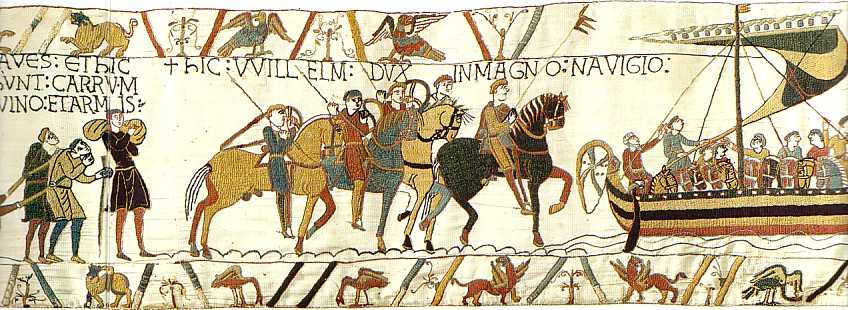
HERE THE SHIPS ARE DRAGGED...
The five men working over the nearly completed pair of ships raise questions. The two shipwrights in the foreground, hammering nails, are bearded; and so in the artform utilized in the Tapestry to portray with stereotypes they could be Englishmen. If so, then William had perhaps more support in England itself than has been accepted. If he knew that the commoners were divided in their opinions about him, it would have given encouragement in the belief that his enterprise actually was practical of success.
Some of these ships are built to use oars, some are without oar tholes. It is doubtful that most of William's 700-odd ships were actually built. Normandy's forests would have been seriously denuded of trees. The bulk of them must have been commandeered by the duke from ports in his own and his vassals' lands, and borrowed from his allies of Boulogne, Brittany and Flanders. But the ships building here certainly catch the eye - while a scene of some Norman requisitioning ships would hardly appeal.
A little detail I wonder at here is the shaping axe used by the righthand figure (straddling the plank): it is the same "tool" as that in the hands of my executioner (just before the "Aelfgyva" figure in the lower margin). Would such an instrument evolve into the headsman's axe? The length of blade would make missing a decapitating stroke less likely. But the blade would have to be deepened to reach all the way through the neck without striking the shaft. (I would have interpreted the "executioner" as a carpenter, except for his nakedness and the mask.)
Some of the ships have figureheads and others do not. But all of these finished ships have oar tholes. In fact, out of the 24 depicted vessels of the Norman fleet 13 of them are so equipped. But none are showing oars being used in any of the following scenes. The crews depend on sail power alone. As earlier noted (when Harold was making his Channel crossing to Ponthieu) the oars seem to be used mainly for maneuvering only in coastal waters.
...TO THE SEA - THESE MEN ARE CARRYING ARMS TO THE SHIPS...
This is one of my favorite scenes. There are many interesting little details. The individuals who are not carrying arms are taking down what appear to be wine skins and smaller barrels of the same. Having quantities of wine for his men saved William's army from dysentary for the first month they were in England; when the wine ran out in November half his men (including himself) were struck down by the flux from drinking the local water. Had he not foreseen this, and not taken enough wine, his army would have been at half strength at the time of the battle of Hastings, and history would look upon a different story. Such is the role of foresight in making history!
No examples of the "ring" pattern are seen here either for these coats of mail being carried. A careful look at the armor depictions in the Tapestry reveals c. 22% of them using strange non-ring patterns - often just the square on the breast is a non-ring pattern: and as already mentioned, most of these non-ring coats show up in the earlier scenes before the Battle. The square on the breast is possibly a flap on the hauberk which could be drawn up over the lower face and tied to the helm or coif. The only "worm in this apple" is the bare-faced fact that squares appear on the breasts of a number of warriors in battle (why would they forego protection?), and those who do not show a square pattern on the breast have full faces showing: probably a mail reinforce is meant, or a frontal opening allowing the mail to be undone and "shucked" by slipping the shoulders out and letting it drop to the ground.
The axe carried by the man with the wine skin on his shoulder is not a weapon: note the shorter cutting edge of the blade, and compare it with those used earlier to chop down trees for William's ships: then again, with the axe in count Guy's hand, those held by the housecarles, and at the end in the battle of Hastings: all of these have the long cutting edge of the two-handed broadaxe. The woodsman's axe could be used as a weapon, of course, but the broadaxe was much lighter and faster and never intended to chop trees.
...AND HERE THEY ARE PULLING A CART WITH WINE AND ARMS - HERE DUKE WILLIAM IN A GREAT SHIP...
The helmets on the cart appear to all have neck guards; but this might be a representation of two helmets stacked on top of each other.
The troops are all wearing their "civilian" clothes but carry their weapons.
This first ship holds the record for number of horses carried - ten. (Don't they look cute?) The horse transports were also crammed with men, as this first depiction makes obvious. It seems reasonable to assume that the knights - at least many of them - chose to across with their steeds, to help keep them under control. The grey-beard at the tiller appears to be also a cleric of some sort: his hand is raised in what is distinctly an invocation. The fellow near the mast seems to be doing likewise. This first ship of the crossing therefore contains a visual depiction of how William's pious troops were blessed by God with a safe passage because his clerics had properly implored the aid of heaven.
The average ship of this knorr style had room for 15 oar benches (there were no "longships" perse in William's fleet, only cargo vessels). This ship could carry 30 to 90 men at one to three men per oar; but a crew of four to six is all that would be required to sail it. Sharing room for supplies and horses, William's fleet of c. 700 ships would have transported an army of roughly 16,000 men and 2,500 horses - if you allow equal space for man and beast. But in fact William would have taken more horses, as many as possible and still keep a balanced army of shock and missile power. A cavalry force of 3,000 to 4,000 is more likely, with proportionally fewer human beings of the infantry sort. Allowing for noncombatants (as few as necessary), William's first-wave invasion force - the one that fought at Hastings - was around 10,000 men of all arms, the cavalry being the largest number, followed by the missile arm (bows, crossbows and slingers), the spearmen infantry being the least numerous arm and least effective or important.




